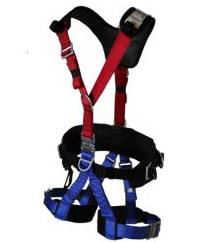Harnesses FAQ
Q: Can I use my fall arrest harness as a rescue harness?
A: Like many equipment questions, this is dependent on the rescue environment and the rescue task at hand. The benefit of using a rescue harness is that these harnesses have several attachment points which allow the rescuer to be lowered and raised comfortably (using the waist or chest attachment points). In addition the attachment points permit the mainline and belay (safety) line to connect to different D-rings.
If rescuer is performing in a fall hazard area and will not be suspended, then a fall arrest harness would suffice.
Q: What is the difference between a fall arrest harness and a rescue harness?
A: Virtually all rescue harnesses manufactured today are rated as a fall arrest harness as well. However, not all fall arrest harnesses are considered appropriate for high angle rescue.
The most basic fall arrest harnesses have no padding and a single D-ring located on the back between the shoulder blades (dorsal D-ring).
Conversely, rescue and rope access harnesses include a chest and waist D-ring. The waist D-ring is the primary point for rappelling and mainline connections. The sternal and dorsal (center back) D-rings are typically used for the belay line.
More and more we are witnessing an evolution within the rescue world of an alignment with OSHA and ANSI fall protection standards. Most notably are the harnesses that are being manufactured for rescue. 
Q: Can the front, sternal “D” ring of a rescue harness by used for fall protection?
A: Yes. In compliance to ANSI 359 and OSHA fall protection criteria, the sternal D-ring may be used as a fall arrest connection point providing that the user does not free fall any further than two feet, and the impact force does not exceed 900 lbs. In essence, OSHA is treating vertical rescue and/or rope access as a work positioning event. When considering work positioning, the user must be using a primary rope connection that is always loaded (mainlines and rappel lines). In addition to primary rope, a secondary rope system (belay line) must be used that limits the fall to less than two feet in the event of a primary rope system failure.
Q: What are the differences between classes of harnesses as stated in NFPA 1983?
- Class I Harness: Often just a belt, it fastens around the waist and thighs or under buttocks, and designed only to be used for emergency escape with one-person loads. Most victim rescue harnesses fall into this category as well.
- Class II Harness: This device fastens around the waist and thighs or under buttocks and is designed for rescue work where two person loads may be encountered. This type of harness may fail if the user becomes inverted. Additionally, Class II harnesses do not meet fall protection criteria.
- Class III Harness: A Class III harness is a full body harness that typically does meet fall protection criteria. This harness fastens around the waist and thighs or buttocks and over the shoulders; designed for rescue where two person loads may be encountered and inverting may occur. This type of harness should almost always be used for technical rescue.
Q: Are shoulder D-ring attachments a good idea for confined space work?
A: A few industrial type rescue harnesses do include shoulder D-rings. The necessity for this type of primary attachment is very dependent type of confined space the user is being lowered into. For example, a vertical opening of 24 inches (or smaller) could be a good reason to use the shoulder attachments to facilitate an extreme vertical orientation of the body. The tradeoff is that this type of extreme vertical harness suspension is very uncomfortable even for short periods of time. The best practice for vertical suspension, especially longer durations, is to have the primary connection to the waist “D” ring.